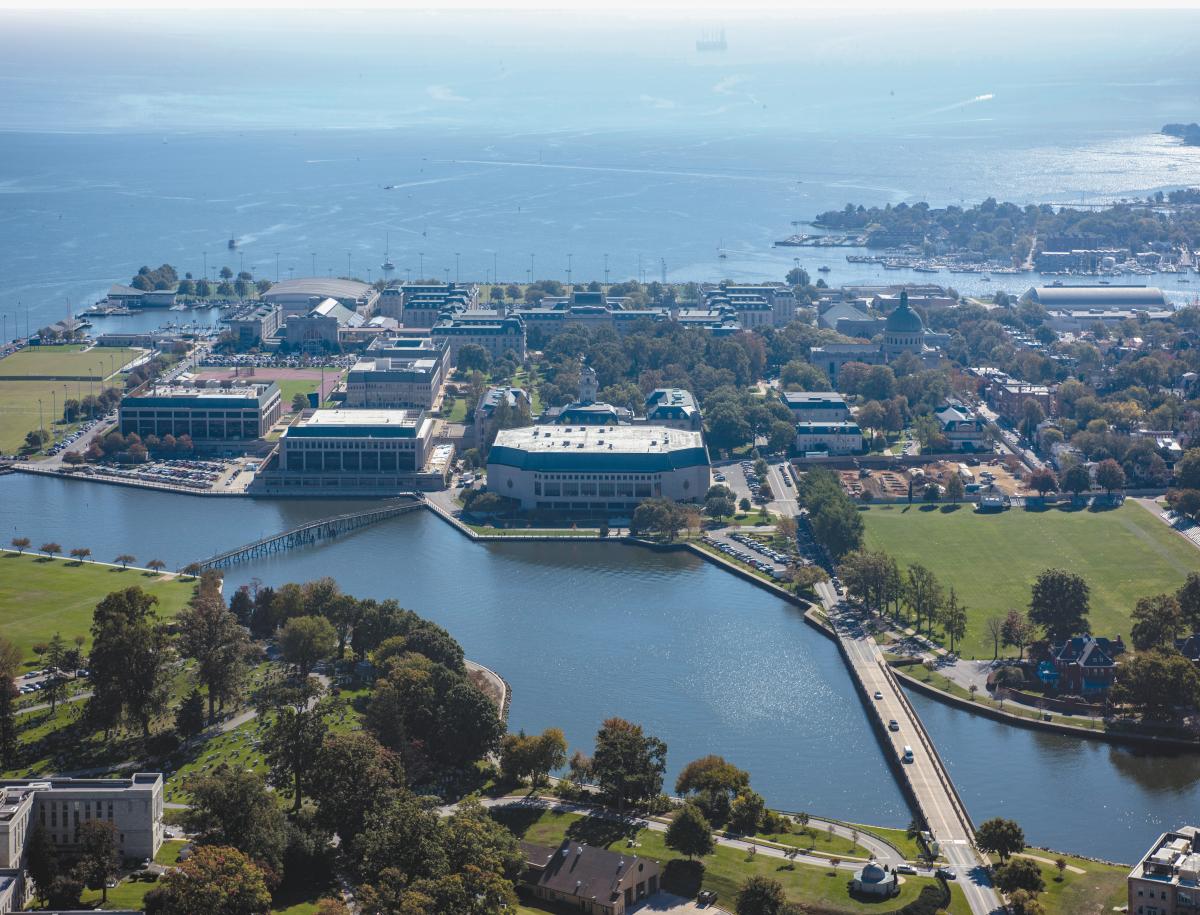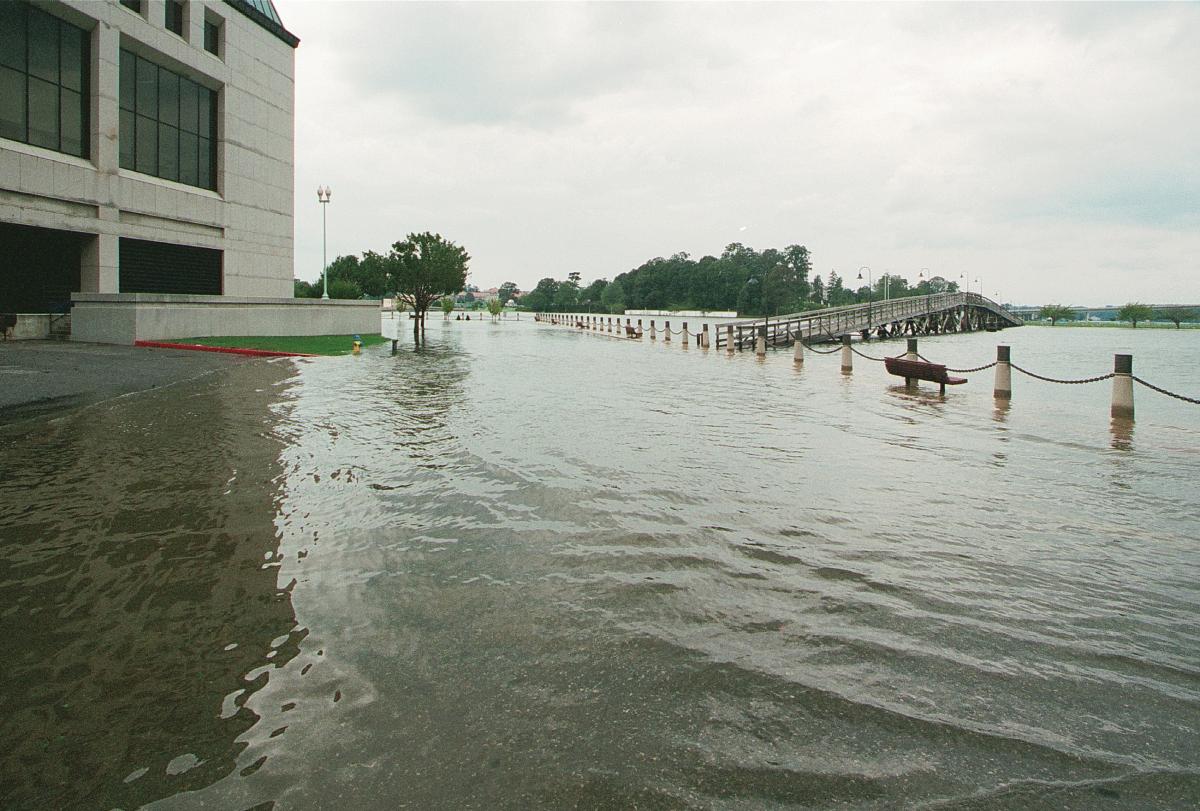Recent climate change models and new evidence of accelerated warming may have fatal consequences for the U.S. Naval Academy in Annapolis, Maryland. Scientists predict that rising sea levels and intense storms will inundate the land it has occupied since 1845. Lacking action now, climate change could force the Navy to relocate the Academy by 2100.
The Academy is only one of scores of U.S. military bases that may be swallowed by rising seas. Even with growing recognition of the problem and a new sense of urgency among U.S. policymakers, there already are too many greenhouse gases in the atmosphere to reverse the gradual warming of the planet.
A Slow-Motion Catastrophe
The Earth already has warmed more than 1.8 degrees Fahrenheit since the Industrial Revolution in the late 18th century. According to a November 2018 U.S. government report, if nations continue to burn fossil fuels at the current rate, the planet may warm as much as nine degrees Fahrenheit by 2100.1 Rising temperatures mean polar ice caps, glaciers, and ice fields in Greenland and Antarctica will continue to melt. This, in turn, will raise sea levels to dangerous levels.
In addition, the pace of climate change is accelerating. In 2007, for example, scientists predicted the Arctic would be free of summer sea ice by 2100. In 2009, they moved it up to 2040. As of December 2018, scientists believe the Arctic will be free of summer ice by the 2030s.2 In 2017, the U.S. National Oceanic and Atmospheric Administration (NOAA) warned that the chances of a sea level rise from six to nine feet “may be more likely than previously thought” and recommended revising the worst case scenario to more than eight feet by 2100.3 The National Climate Assessment report mirrors evidence by a global alliance of scientists who have combined forces to address the problem. The Intergovernmental Panel on Climate Change (IPCC)—an intergovernmental body of the United Nations dedicated to providing an objective, scientific view of climate change—reported in October 2018 that the world is racing toward a temperature rise of 2.7 degrees Fahrenheit much faster than previously predicted.4
On 23 November 2018, the U.S. Global Research Program (USGRP)—a federal program mandated by Congress to facilitate federal agency coordination on issues such as climate change—published the Fourth National Climate Assessment, which warns of a large-scale, worldwide environmental disaster. The 13 USGRP agencies, led by NOAA, reported rapidly deteriorating environmental conditions related to climate change: massive, uncontrollable forest fires; hyper-powerful hurricanes; devastating droughts; and suffocating heat waves. The long-term consequences could be catastrophic.
Academy at Risk
Surrounded by water on three sides, the Naval Academy is especially vulnerable to sea rise. The Severn River runs along the east, Spa Creek extends to the south, and College Creek runs along the north. Parts of the Academy adjacent to the water—Forrest Sherman Field, Dewey Field, Ingram Field, Farragut Field, Rip Miller Field, Worden Parade Field, the areas around Lejeune Hall and Halsey Field House, Luce Hall, MacDonough Hall, and Alumni Hall—stand just over three feet above the water line. The highest position (nearly 40 feet above the water line) on the Academy’s 338 acres is the former Navy Health Clinic at Hospital Point.
Sea levels around Annapolis have risen about one foot over the past 100 years.5 While sea rise in the next few decades depends on a number of factors—mankind’s ability to reduce greenhouse gases, advances in renewable energy technology, the rate of ice melt in Antarctica—it could rise as much as eight feet by 2100.6
The Academy and Annapolis already are experiencing the effects of climate change. Annapolis has seen the highest increased rate of coastal flooding in the United States.7 In 2018, the downtown area flooded about once a week from high tides, threatening businesses along the City Dock and Market Street. Next door, the Academy also sees evidence of rising water. Low-lying areas adjacent to College Creek frequently are closed by high water. According to the Union of Concerned Scientists, a group that has warned of the effects of global warming for years, these areas will flood daily rather than weekly by 2050.8
Academy Takes Action
In response, the Navy and Academy staff have gone on the offensive. In 2015, they formed the Sea Level Rise Advisory Council to create an adaptation plan and make decisions about flood-related matters. Currently, Academy staff are installing door dams and flood barriers on doorways, repairing seawalls, and installing back-flow preventers in storm drain systems to reduce flooding. Newly constructed buildings, such as Hopper Hall, will have elevated entrances and limited first-floor openings to keep out rising water. Navy leaders in Annapolis also reportedly are considering installing giant underground reservoirs to capture stormwater until floodwaters recede. The Academy also may install dewatering pumps to move floodwaters off inundated areas and back into Spa Creek or the Severn River.
The biggest preventive measure the Academy will take is improving the seawall that extends around three-quarters of the yard’s perimeter. Academy leaders plan to strengthen existing portions and construct a two- to four-foot extension on top of the existing seawall that can be raised as conditions worsen. Construction will begin in fiscal year 2020. As seawater also can creep up through saturated soil, the wall will be buried below the surface. To permit access to sailing vessels and crew rowing shells, personnel and vehicle entrances will be built into certain areas along the lower yard perimeter wall.
Other Climate-Related Threats
Flooding from sea level rise is not the only threat to the Naval Academy. The November 2018 U.S. Climate Assessment reported that Atlantic Coast hurricanes will grow in size and strength because of global warming. These super storms—such as the Category 5 Hurricane Dorian, which nearly leveled Grand Bahama Island on 2 September—could flood the low-lying Academy property and cause irreparable damage. Hurricane Florence, for example, struck North Carolina in September 2018 with a storm surge of 9–13 feet and dumped 20–30 inches of rain on the Marine Corps Base at Camp Lejeune. Damages were estimated at $3.6 billion.9
In 2003, Hurricane Isabel caused more than $100 million in flood damage at the Academy. The storm surge breached the seawall and flooded academic buildings, laboratories, and training facilities. Some parts of the facility were under eight feet of water. The Academy required years of costly construction to repair the damage and had to manage with major disruptions to staff, faculty, and midshipmen.10 Should another storm like Isabel hit Annapolis, Navy leaders would have to decide if repairing the damage makes sense, given deteriorating environmental conditions and competition for improvements to other Navy installations that also must be hardened against climate change threats.
Is Climate Change Reversible?
To reduce greenhouse gases, nations will have to quickly restructure their entire energy systems, switching from fossil fuel systems to renewable energy systems such as wind, solar, or hydroelectric power. But the switch must happen rapidly and will involve significant capital investment. In addition, the world population is expanding rapidly toward 11 billion people by 2100 with an insatiable appetite for development, growth, and comfortable standards of living.
The near-constant litany of bad news on climate change is a warning that mankind is in trouble. After some initial exuberance following the December 2015 Paris Climate Accord, under which participants agreed to reduce global emissions, a number of participants expressed doubts. One scientist said, “The pledges are a big step forward but not sufficient. . . . Not even close.”11 The conference agreement was nonbinding; each country made only a voluntary commitment to reduce emissions, and there is no enforcement mechanism.
There also are worries that the world’s biggest polluters—China, the United States, India, Brazil, Canada, Russia, Indonesia, and Australia—may not have the political will to curb greenhouse gases when faced with booming populations, increasing energy demands, and fragile economies. Four years after the Paris Accord, no major industrialized nation is on track to meet the goals it agreed to in 2015.12
It could get worse. The West Antarctic Ice Sheet will collapse into the ocean, raising sea levels by another ten feet, unless action is taken soon. In the 2018 USGRP report, federal science agencies warned that if the Greenland Ice Sheet melts, it will create an additional 20 feet of sea rise. Former NASA climatologist James Hansen puts that in perspective: “That would mean the loss of all coastal cities, most of the world’s major cities, and all of their history.”13 If the massive East Antarctic Ice Sheet disintegrates and spills into the ocean—almost inevitable, unless nations take action—sea levels could rise by about 200 feet.14
Even if countries comply with the Paris Climate Accord, the global effort may have come too late. So much human-created greenhouse gas has accumulated in the atmosphere that it will take hundreds of years to be absorbed by the oceans and forests. The melting of ice fields in Antarctica and Greenland will continue even if carbon dioxide and other greenhouse gases are brought under control. Sea level rise will continue for centuries until the atmosphere can clean itself of residual contaminants, a process scientists refer to as “deep decarbonization.”15
The Naval Academy isn’t the only military base facing an existential threat from climate change. The Department of Defense has more than 1,200 military bases in the United States. A study conducted at the behest of the Chief of the Naval Operations determined that more than 50 of these bases that are at “very high risk” or “high risk” from climate threats are naval installations. The most at-risk installations include Naval Air Station Key West in Florida, Naval Air Station Oceana/Dam Neck in Virginia, and Marine Corps Recruit Depot Parris Island, South Carolina.16
1. David Reidmiller, et al.; Fourth National Climate Assessment, U.S. Global Change Research Program (Washington, DC: 2018): Appendix 5, 19.
2. For accelerating Arctic ice melt predictions, see Congressional Research Service (CRS), “Climate Change: Science and Policy Implications,” 2 May 2007, 32; CRS, “Climate Change: Science Highlights (CRS Report RL34266)”, 23 February 2009, 8; CRS, “Changes in the Arctic: Background and Issues for Congress,” 13 December 2018, 19.
3. W. V. Sweet, et al., “Global And Regional Sea Level Rise Scenarios For The United States” in NOAA Technical Report NOS CO-OPS 083 (Silver Spring, MD: January 2017), vi, 14, 21, and 23.
4. Intergovernmental Panel on Climate Change (IPCC), “Global Warming of 1.5°C.” October 2018; Chris Mooney and Brady Dennis, “The World Has Just Over a Decade to Get Climate Change Under Control, U.N. Scientists Say,” Washington Post, 7 October 2018; Brad Plumer and Nadja Popovich, “Why Half a Degree of Global Warming Is a Big Deal,” New York Times, 7 October 2018.
5. Maryland government homepage.
6. The Naval Academy is using an intermediate to intermediate-high estimate of sea rise by 2100 (two- to four-foot sea rise) for its planning purposes.
7. National Oceanic and Atmospheric Administration (NOAA), “’Nuisance Flooding’ an Increasing Problem as Coastal Sea Levels Rise,” 28 July 2014; NOAA, “Sea Level Rise and Nuisance Flood Frequency Changes around the United States,” in NOAA Technical Report NOS CO-OPS 073 (June 2014). See also, Angela Fritz, “Mid-Atlantic Has Largest Rise in Nuisance Flooding Since the 1960s,” The Washington Post, 29 July 2014.
8. Union of Concerned Scientists, “The US Military on the Front Lines of Rising Seas” (2016).
9. Shawn Snow, “$3.6 Billion Price Tag to Rebuild Lejeune Buildings Damaged by Hurricane Florence,” Marine Times, 12 December 2018.
10. NOAA, Hurricane Isabel, September 18–19, 2003 report (May 2004); Jason Samenow, “If Hurricane Sandy Had Come South: Worst Case Storm Surge Scenario For Washington, D.C.,” The Washington Post, 1 November 2012.
11. Justin Gillis and Somini Sengupta, “Progress Seen in New Goals on Warming,” The New York Times, 28 November 2015.
12. Chris Mooney, “Countries Vow to Cut Carbon Emissions. They Aren’t Even Close to Their Goals, U.N. Report Finds,” Washington Post, 27 November 2018; Somini Sengupta, “The Paris Accord Promised a Climate Solution; Here’s Where We Are Now,” The New York Times, 16 December 2018.
13. J. Hansen, et al., “Ice Melt, Sea Level Rise and Superstorms: Evidence from Paleoclimate Data, Climate Modeling, and Modern Observations that 2°C Global Warming Is Highly Dangerous,” Atmospheric Chemistry and Physics 15, 2015; Justin Gillis, “Scientists Warn of Perilous Climate Shift within Decades, Not Centuries,” The New York Times, 23 March 2016, A11.
14. U.S. Global Change Research Program, National Climate Assessment, Appx. 5, 52–53 (November 2018). There is little debate among climatologists that the continued rise of global temperatures as a result of human-created greenhouse gases will cause the melt of the polar ice caps. What scientists are unsure of is when it will occur. Estimates range from one to two centuries. See Michael Mann and Tom Toles, The Madhouse Effect (New York: Columbia University Press, 2016), 27–29.
15. W. V. Sweet, et al., “Global And Regional Sea Level Rise Scenarios for the United States,” 1.
16. See National Research Council, “National Security Implications of Climate Change for U.S. Naval Forces,” Washington DC: National Academy of Sciences, 2011, 74. The NRC study was overseen by Navy Admiral Frank “Skip” Bowman, former Chief of Naval Personnel and Director of Naval Nuclear Propulsion. See also Union of Concerned Scientists, “The U.S. Military on the Front Lines of Rising Seas,” 2016.





